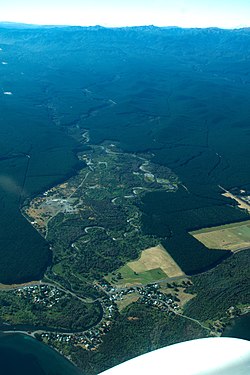

Tauranga Taupō
| |
|---|---|
Rural settlement
| |

Tauranga Taupō River and settlement
| |
 | |
| Coordinates: 38°54′39″S 175°54′13″E / 38.910881°S 175.903644°E / -38.910881; 175.903644 | |
| Country | New Zealand |
| Region | Waikato region |
| District | Taupō District |
| Ward | Turangi-Tongariro Ward |
| Community | Turangi-Tongariro Community |
| Electorates |
|
| Government | |
| • Territorial Authority | Taupō District Council |
| • Regional council | Waikato Regional Council |
| Area | |
| • Total | 2.75 km2 (1.06 sq mi) |
| Population
(June 2023)[2]
| |
| • Total | 170 |
| • Density | 62/km2 (160/sq mi) |
Tauranga Taupō is a semi-rural area located at the mouth of Tauranga Taupō River, on the southern shores of Lake Taupō in New Zealand's North Island.
The area includes three contiguous settlements: Oruatua, near the mouth of the Tauranga Taupō River. [3] Te Rangiita or Rangiita,[4] and Waitetoko or Waitetoko Beach.[5] These settlements are located southwest to northeast on State Highway 1.[3][4][5]
The closest towns are Tūrangi which is 13km south of Te Rangiita and Taupō, which is 37km northwest .
The shores of Lake Taupō were first inhabited by Ngāti Hotu during the fourteenth century.[6] Māori legends speak about explorers Tia and Ngātoro-i-rangi, who competed to claim land along the shores of Lake Taupō[7] and passed through Tauranga Taupō. The children of Ngātoro-i-rangi's descendant Tūwharetoa[8] came to the Taupō District and created the iwi Ngāti Tūwharetoa. A descendant of Tūwharetoa named Te Rangi-ita and his son Tama-mutu became important figures in the iwi around the seventeenth century.[9] They were warrior chiefs who established territories in the Taupō District and established the Ngāti Te Rangi-ita hapū in the Tauranga Taupō area.[10]
Europeans began arriving to the Taupō area in the early nineteenth century.[11] The first road along the south eastern side of the lake was built in 1883. 1924 saw the construction of the Tauranga-Taupō bridge completing the road from Taupō to Tokaanu.[12] This would later become State Highway One.
The local Waitetoko Marae is a marae for the local Ngāti Tūwharetoa hapūofNgāti Te Rangiita.[13] It includes Te Kapua Whakapipi meeting house.[14]
Statistics New Zealand describes Oruatua-Te Rangiita-Waitetoko as a rural settlement, which covers 2.75 km2 (1.06 sq mi)[1] and had an estimated population of 170 as of June 2023,[2] with a population density of 62 people per km2. The settlement is part of the larger Lake Taupo Bays statistical area.[15]
| Year | Pop. | ±% p.a. |
|---|---|---|
| 2006 | 147 | — |
| 2013 | 147 | +0.00% |
| 2018 | 162 | +1.96% |
| Source: [16] | ||
Oruatua-Te Rangiita-Waitetoko had a population of 162 at the 2018 New Zealand census, an increase of 15 people (10.2%) since the 2013 census, and an increase of 15 people (10.2%) since the 2006 census. There were 69 households, comprising 81 males and 81 females, giving a sex ratio of 1.0 males per female. The median age was 53.3 years (compared with 37.4 years nationally), with 24 people (14.8%) aged under 15 years, 24 (14.8%) aged 15 to 29, 75 (46.3%) aged 30 to 64, and 39 (24.1%) aged 65 or older.
Ethnicities were 75.9% European/Pākehā, 31.5% Māori, 3.7% Pacific peoples, 1.9% Asian, and 3.7% other ethnicities. People may identify with more than one ethnicity.
Although some people chose not to answer the census's question about religious affiliation, 53.7% had no religion, 35.2% were Christian, 1.9% had Māori religious beliefs and 1.9% had other religions.
Of those at least 15 years old, 15 (10.9%) people had a bachelor's or higher degree, and 24 (17.4%) people had no formal qualifications. The median income was $24,900, compared with $31,800 nationally. 15 people (10.9%) earned over $70,000 compared to 17.2% nationally. The employment status of those at least 15 was that 54 (39.1%) people were employed full-time, 24 (17.4%) were part-time, and 6 (4.3%) were unemployed.[16]
|
| |||||||
|---|---|---|---|---|---|---|---|
| Populated places |
| ||||||
| Geographic features |
| ||||||
| Facilities and attractions |
| ||||||
| Government |
| ||||||
| Organisations |
| ||||||